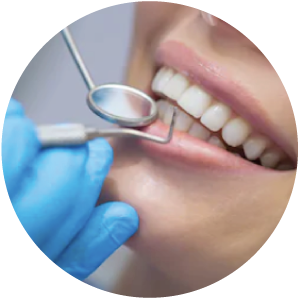
Our practice can provide a wide range of dental services. We can typically provide every type of dental service without having to refer you to other specialties. This flexibility saves you time and keeps your total dental care within one practice. Our emphasis is on total preventive care for our patients. Total care begins with regular hygiene visits, regular check-ups and continued home oral health routines.
Our practice also provides the highest-quality services for restoring mouths that have been damaged by dental disease and injury and common problems that require cosmetic dentistry. Our primary goal for our patients is to achieve and maintain optimum oral health through advances in techniques, technologies and by maintaining their scheduled dental exams.
Click on the title of each section below to learn more.

+ Teeth Cleaning
You should schedule a routine dental cleaning every six months. During this visit, one of our dental hygienists will remove plaque from your teeth, especially from places where your brush can’t reach, such as underneath the gum line and in-between teeth. We will then clean your teeth and apply fluoride to help protect your teeth once you leave the office.
Fluoride is a relatively recent but important advancement in dental and oral health. Studies consistently show that a moderate but consistent exposure of teeth to fluoride helps strengthen and rebuild tooth structure, and helps prevent future decay.
If you are due for your annual dental cleaning, please make an appointment today.

+ Fillings
The concept of a “filling” is replacing and restoring your tooth structure that is damaged due to decay or fracture with a material. We will replace old, broken-down amalgam/metal fillings that contain traces of mercury with white fillings (composites) to restore your smile and teeth to a more natural look and feel.
With today’s advancements, no longer will you have to suffer the embarrassment of unsightly and unhealthy silver/mercury fillings or metal margins of the past. Eliminate the dark, black appearance in your teeth with new-age, state-of-the-art, tooth-colored resin or porcelain materials.

+ Crowns
A crown is a custom-made covering that fits over an original tooth that is either decayed, damaged or cracked. Crowns are made of a variety of different materials such as porcelain, gold, acrylic resin or a mix of these materials. Porcelain generally has the most natural appearance, although it is often less durable.
The treatment plan for a patient receiving a crown involves:
Numbing the tooth to remove the decay in or around it.
Re-sculpturing the tooth to provide an ideal fit for the crown.
Making an impression of your teeth in order to create a custom-made crown (usually takes one to two weeks).
Making a temporary crown out of acrylic resin and fitting it onto the tooth during the interim period when the custom-made crown is being created.
Applying the custom-made crown (when received from the lab) by removing the temporary crown and fitting the custom-made one onto the tooth.
After ensuring that the crown has the proper look and fit, the dentist cements it into place.
This process generally consists of a minimum of two to three visits over a three to four week period. Once the procedure is completed, proper dental hygiene, including daily brushing and flossing, is required to maintain healthy, bacteria-free teeth, gums and crowns. This helps in the prevention of gum disease.
Given proper care, your crowns can last a lifetime.

+ Bridges
A bridge is a dental device that fills a space that a tooth previously occupied. A bridge may be necessary to prevent:
Shifting of the teeth that can lead to bite problems (occlusion) and/or jaw problems and resultant periodontal disease.
Bridges safeguard the integrity of existing teeth and help maintain a healthy, vibrant smile.
There are three main types of bridges, namely:
A fixed bridge is the most popular and consists of a filler tooth that is attached to two crowns, which fit over the existing teeth and hold the bridge in place. The cantilever bridge is often used when there are teeth on only one side of the span. A typical three-unit cantilever bridge consists of two crowned teeth positioned next to each other on the same side of the missing tooth space. The filler tooth is then connected to the two crowned teeth, which extend into the missing tooth space or end.

+ Implants
Dental implants are artificial tooth replacements that were first developed half a century ago by a Swedish scientist named Per-Ingvar Branemark. Implants arose from the patient’s need to secure loose-fitting dentures. Since the advent of the implant, engineering and enhancements to the implant have enabled dentists to expand the implant’s usefulness, including the replacement of missing or lost teeth. Today, implant techniques provide a wide range of tooth replacement solutions including:
• Single Tooth Replacement
• Anterior Replacement
• Posterior Replacement
• Full Upper Replacement
• If the missing tooth space has no surrounding teeth, the dentist may decide an implant is the most appropriate treatment choice or option.

+ Post Implant Care
Although proper oral hygiene is always recommended for maintaining good dental health, it is especially important when a patient has received a dental implant. Bacteria can attack sensitive areas in the mouth when teeth and gums are not properly cleaned, thus causing gums to swell and jaw bones to gradually recede. Recession of the jawbone will weaken implants and eventually make it necessary for the implant to be removed. Patients are advised to visit their dentists at least twice a year to ensure the health of their teeth and implants. Dental implants can last for decades when given proper care.

+ Root Canal
A root canal is a procedure that extracts decayed pulp from the central part of the tooth, reshapes the canal and replaces it with strengthening filler.
A cavity is the result of superficial decay of the enamel of the tooth. Left long enough, this decay can burrow into the deeper reaches of the tooth, causing extensive damage to tooth structure. When the damage goes beyond what can be treated with a filling, dentists can perform a root canal (or endodontics), preserving the tooth and retaining its original integrity; thereby, saving a tooth that in the past would have to have been pulled.
Procedure
A dental dam is used to isolate the tooth.
The tooth is opened to allow for removal of infected or dead dental pulp.
The tooth is comprehensively cleaned, including any cracks and canals.
With special tools, the doctor reshapes the canals.
The tooth is filled again with cutting edge biocompatible filling material.
A temporary covering is used to cover the access opening.
A permanent restoration must be placed quickly upon completion of a root canal.
General Extractions
An extraction is the complete removal of a tooth. Extractions are sometimes necessary if a primary tooth is preventing the normal eruption of a permanent tooth, if the tooth has suffered extensive tooth decay or trauma that cannot be repaired, if the patient has gum disease, or if the tooth is impacted (usually the wisdom teeth). Depending on the complexity of the case, an extraction can be performed surgically or non-surgically. A mild anesthesia is used to ensure your child is as comfortable as possible throughout the procedure.

+ Wisdom Teeth
Your third molars are more commonly called “wisdom teeth.” Usually appearing in the late teens or early twenties, third molars often lack the proper space in the jaw to erupt fully or even at all. This common condition is called impaction. When any tooth lacks the space to come through or simply develops in the wrong place of your jaw and becomes impacted, problems can arise. Primarily, damage to adjacent teeth and crowding occur.
In certain cases, the wisdom tooth that cannot come through becomes inflamed under the gums and in the jawbone, causing a sac to develop around the root of the tooth that then fills with liquid. This can cause a cyst or an abscess if it becomes infected. If either of these situations goes untreated, serious damage to the underlying bone and surrounding teeth and tissues can result.
To potentially stave off this result, an extraction of one, several or all of the wisdom teeth may be advised. If that is the case, an oral surgeon has the equipment and training needed to perform such extractions, with an absolute minimum of discomfort. Ask our staff for referral information to an oral surgeon regarding tooth extractions.


